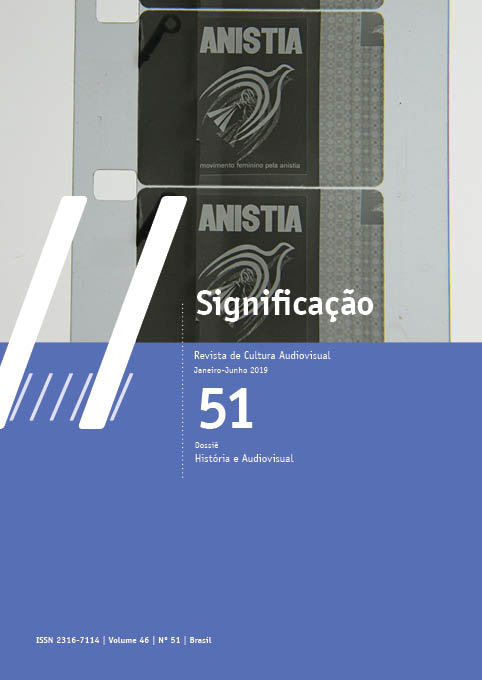The testimony of the enemy
the confrontation in the elaboration of the past in Rithy Panh
DOI:
https://doi.org/10.11606/issn.2316-7114.sig.2019.147848Keywords:
documentary, memory, aesthetics, testimony, archiveAbstract
This article analyzes the film Duch, le maître des forges de l’enfer (Duch, the master of the forges of hell, 2012) by Rithy Panh, from the considerations of establishing a relationship with the enemy elaborated by Comolli in 2008. Within the narratives of catastrophes, where a traumatic past must be dealt with, the testimony and the use of archives in the production of historical memories are mostly done from the victims’ point of view. The film brings another perspective when facing oblivion through a dictator’s word. Thus, the film must confront Kaing Guek Eav’s attempts to take the floor by creating situations in the mise-en-scène and associations in its montage.
Downloads
References
COMOLLI, J. L. “Como filmar o inimigo?” In. Ver e poder. A inocência perdida: cinema, televisão, ficção, documentário. Belo Horizonte: Ed. UFMG, 2008, p. 121-134.
DELEUZE, G. A imagem-tempo. São Paulo: Brasiliense, 2007.
GAGNEBIN, J. M. Lembrar escrever esquecer. São Paulo: Editora 34, 2009.
LEANDRO, A. “A história na primeira pessoa: em torno do método de Rithy Panh”. E-compós, Brasília, v.19, n.3, set./dez. 2016.
PANH, R. “A palavra filmada”. In: Maia, C., Flores, L. F. (orgs.). O cinema de Rithy Panh. Centro Cultural Banco do Brasil, 2013a, p. 75-109.
______. The elimination. Londres: The Clerkenwell Press, 2013b.
______. “Meu projeto excede o de um cineasta: Entrevista com Rithy Panh”. In: Maia, C., Flores, L. F. (orgs.). O cinema de Rithy Panh. Centro Cultural Banco do Brasil, 2013c, p. 235-247.
ROLLET, S. “Devolver o olhar”. In: Maia, C., Flores, L. F. (orgs.). O cinema de Rithy Panh. Centro Cultural Banco do Brasil, 2013, p. 199-227.
SELIGMANN-SILVA, M. “Narrar o trauma: a questão dos testemunhos de catástrofes históricas”. Psicol. clin. [online], Rio de Janeiro, vol. 20, n.1, p. 65-82, 2008.
______. A atualidade de Walter Benjamin e Theodor W. Adorno. 2ª edição. Rio de Janeiro: Civilização Brasileira, 2010.
Downloads
Published
Issue
Section
License
Copyright (c) 2019 Tomyo Costa Ito

This work is licensed under a Creative Commons Attribution-NonCommercial 4.0 International License.
Authors who publish in this journal must agree with the following terms:
- Authors keep their copyrights and grant the journal first time publication rights, having their articles simultaneously licensed under the Creative Commons Attribution License, which allows sharing texts with authorship recognition and first publication on this journal for non-commercial purposes.
- Authors are allowed to make additional contracts, for a non-exclusive distribution of the article’s version published on this journal (e.g.: publishing in institutional repositories of articles or as a book chapter), with authorship recognition and first publication on this journal.
















